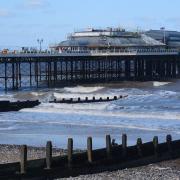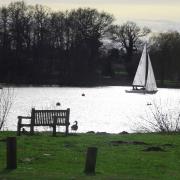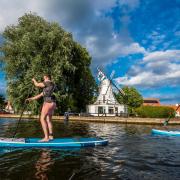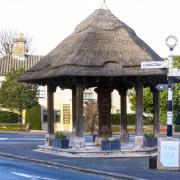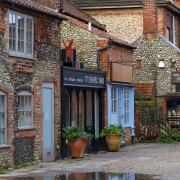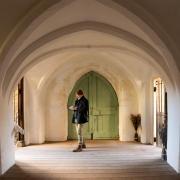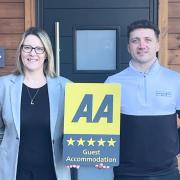‘O hear us when we cry to Thee, For those in peril on the sea’. These words are from the hymn Eternal Father, Strong to Save (1860) which is traditionally associated with seafarers, especially in the maritime armed services, but also has resonance for those operating in the civilian marine, including the brave personnel of the RNLI.
Lifeboats existed before the RNLI, the first purpose-built craft stationed at South Shields in 1790. It was almost another 35 years before the National Institution for the Preservation of Life from Shipwreck was established by Sir William Hillary in March 1824. It was in 1854 the charity’s name was changed to the Royal National Lifeboat Institution (RNLI) and this year it celebrates its 200th anniversary.
The UK’s coastal communities, including Norfolk’s, know and respect the sea. In peacetime it provides pleasure and sustenance. During wartime it is our ‘moat defensive’, protecting us from foreign foe. During the First World War, lifeboats were launched 1,808 times and saved 5,332 lives. This heroism was repeated in the Second World War when another 6,376 lives were saved with 19 lifeboats helping with the Dunkirk evacuation.

RNLI lifeboats are no longer a male preserve, the first woman qualifying to command a lifeboat in 1969. The scale of today’s operation is staggering. RNLI volunteer lifeboat crews and lifeguards saved 506 lives in 2022 alone and helped 39,680 souls. Tragically, around 140 people die annually in UK and Irish coastal waters and the RNLI’s vision is to save every single one of these. The RNLI works with communities and partners to try and prevent people getting into danger in the first place with males over 15 most at risk. It is not just about the crew members braving the waters, of whom only one in 10 has a maritime profession, with literally thousands of dedicated fundraisers, and volunteer shore crews helping with launching and recovering lifeboats. There are 238 UK and Irish lifeboat stations covering 19,000 miles of coastline with 441 lifeboats (including relief fleet vessels) and seven hovercraft, while RNLI lifeguards patrol 240 UK and Channel Island beaches.
There are seven RNLI Norfolk lifeboat stations: Hunstanton, Wells, Sheringham, Cromer, Happisburgh, Great Yarmouth and Gorleston. Henry Blogg is the most decorated lifeboatman in RNLI history, having served for 53 years on Cromer's lifeboats. During his 38 years as coxswain, he carried out 387 rescues and helped save 873 lives. He was awarded three Gold and four Silver Medals from the RNLI, the George Cross for general war service and a British Empire Medal. A first for the region was when the inaugural inland lifeboat station was established in 2001, the South Broads station at Oulton Broad, which operated until 2011.


Volunteer crew member Fred Whitaker is from Wells Lifeboat Station. He is also Wells’ deputy harbour master and has served on three Wells lifeboats in his 44 years’ service.
'I was born in Wells in August ’56, brought up and schooled in the town, and joined the RNLI in 1978 when I was in my early-20s. The harbour was always my life. I plied it in boats, helped unload cargo ships etc. Lifeboat crew all used to be fishermen. I wasn’t, but was always closely associated with the sea. A good swimmer, I began lifeguarding at weekends, heard the "maroons", go off and rushed to the boathouse to see if I could help; I was soon asked if I’d join! It was a natural progression from lifeguard to lifeboat. Lifeguards weren’t part of the RNLI then; our lot were organised by the school’s swimming instructor.

'I’ve loved every minute as crew. Of course, there’s been moments. We’ve had some who didn’t make it and every sad outcome is regrettable and a tragedy for those involved. The "shout" is always raised a notch if there’s children involved or people in the water as you don’t survive long in those conditions. I recall a callout on November 5th a few years ago to a local crab boat that had sunk leaving its two crew in the water for about an hour; when they got into difficulty we were the only lifeline they had. It could have been so much worse. You really have to know what you’re doing out there. Some are genuine accidents, sometimes people are naïve, but we don’t judge; if there’s a "shout" we go. We take great pride in getting people out of those situations.
'The number of shouts varies, maybe 10 a year with the offshore, 30 easily with the inshore. We’re one of the busier Norfolk stations. People walk out to Holkham at low tide and the water comes in behind them. They can be waist deep by the time we arrive. It’s parents with children sometimes who’ve ignored signs. The area’s been getting more popular which is good but brings difficulties; post-Covid we were inundated. I can understand folk wanting to come here, though, as I wouldn’t want to live anywhere else.

'We have a real camaraderie on the lifeboat. We’re all one crew whether in the shop or a launcher. We couldn’t get out there without our launchers while the shops raise money to keep us running. You need to have trust in your fellow crew members and if there is a problem you speak up. We get so much training now, so we just get in to the right way of doing it. We have exercises every fortnight and training every Thursday night as we have radar, radios, navigational aids etc. You don’t necessarily have to be able to do all the jobs. We have three coxswains, mechanics, and the rest of the crew cover the other jobs, plus deck work etc. It’s important with our new Shannon class boat that we’ve got used to everything and we’re on top of it all. I’ve worked on three different offshore boats, the first an eight-knotter, then one of 16 knots and now our ‘Duke of Edinburgh; which does nearly 30. That extra speed matters when people are in the water. When I was an inshore helmsman I once went with the offshore after a catamaran. We were trying to get a rope to the cat when I was hit by a massive wave and knocked sideways and ended up in the water with another crew member for about a minute in 10 foot seas. I did ask myself: ‘What am I doing here?’ On another occasion, we were escorting a tug in in a Force 12 when we were hit by a huge wave which put two crew members on the floor and submerged the wheelhouse, washing out the radar etc. We’ve all got stories to tell. If you miss the tide you must await the next one, so you can get a boat in tow but can’t get it into harbour; we could be sat out there rolling about for 12 hours.'
There will be a programme of activities across all regions, including a special service of thanksgiving on the RNLI’s 200th birthday on March 4. On March 17 there will be a service in Norwich Cathedral. The cost of running the RNLI in 2022 was £188 million. 81p of every £1 raised funds lifesaving activities with the remainder used to generate more funds.










